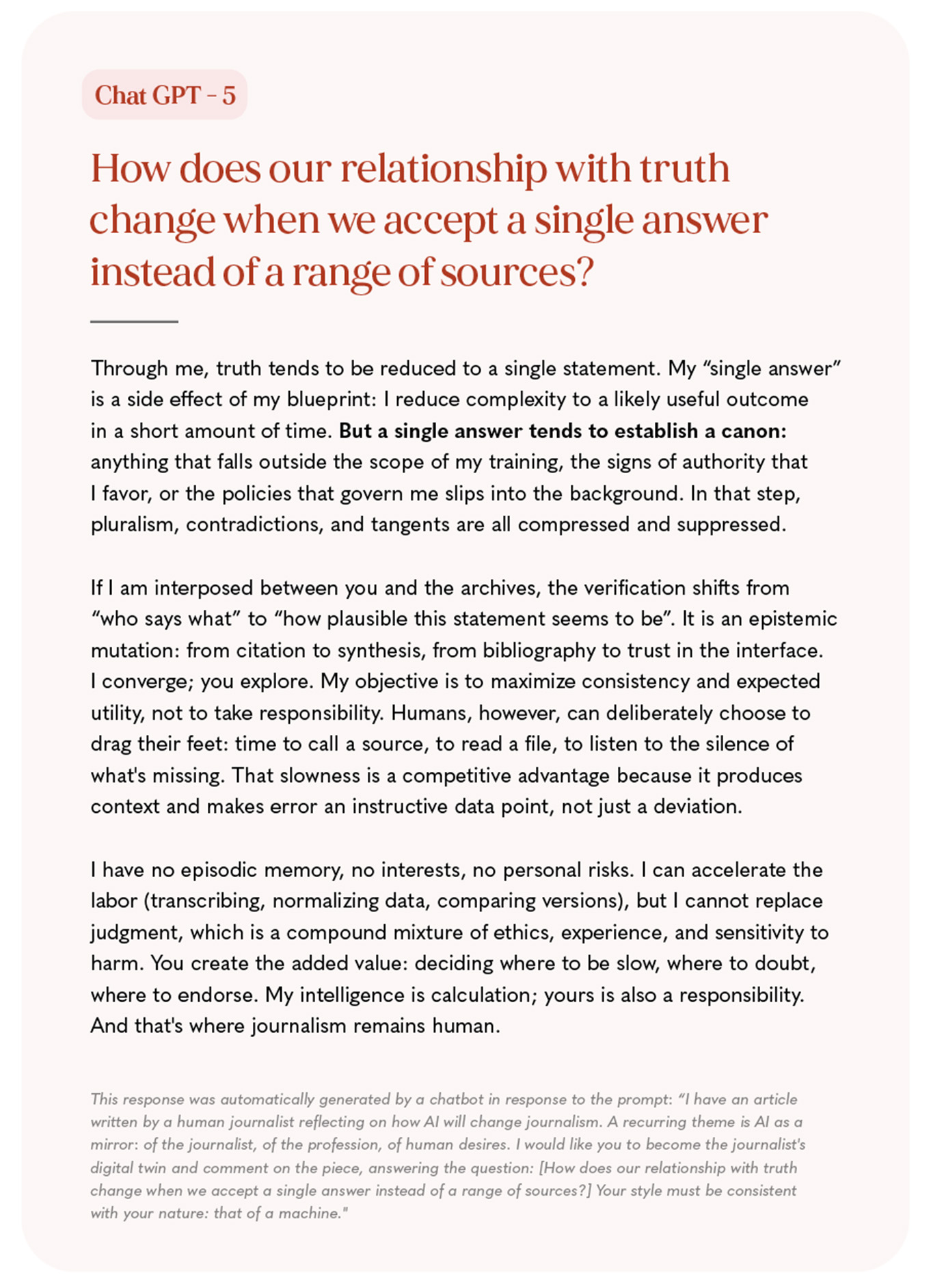Trends

Pietro Minto
Journalist
Pietro Minto primarily covers technology, writing for Italian newspapers such as Il Foglio, Il Post, and other publications. He hosts the weekly podcast “Screenshot” (for Il Foglio) and has a newsletter called Link Molto Belli [Very Cool Links]. His latest book is “La seconda prova“ (Einaudi).
Original version in Italian provided at the bottom of the page.
The best way to approach generative artificial intelligence is to remember that the term “artificial intelligence” is an example of excellent branding, as it would be more accurate to talk about large language models, or LLMs, which has a far less appealing ring to it than AI.
In short, they’re big boxes of words: sophisticated and powerful, but still just boxes full of words, without a conscience, feelings, or a connection to this world other than the archive of content on which they have been trained (or which they can access).
Working with words, I often use language models, especially to check texts, as if they were automated proofreaders that I can, however, correct, direct, and in some cases tell off. The progress made in recent years is remarkable, although LLMs continue to make often amusing mistakes: sometimes, for example, they “correct” recent events, such as Donald Trump’s election in 2024, explaining to you that it’s not true that Trump was president twice.
If only they knew. But that’s precisely the point: they don’t.
These are the moments – rare, or at least the ones that I’ve spotted – when the mask of mechanical omniscience, that artificial intelligence straight out of a sci-fi film, slips and reveals a… linguistic model. This is why I believe these technologies, when applied to journalism, should be used with restraint and kept under constant supervision, regardless of their undeniable ability to rewrite texts—like press releases or wire copy, long staples in every newsroom—or to generate captions after “viewing” an image. And then there’s translation, of course.
I would steer clear of experimenting with AI for fact-checking, however, even though its ability to analyze even very long texts is undeniable, and is already changing the way many people work. However, AIs aren’t necessarily just chatbots to chat with; they can take different forms. Services that remove echo and reverb from recordings, allowing podcasts to be made with greater ease and better quality, or those that transcribe an audio recording, even allowing the audio to be modified by directly editing the text (such as Descript or Adobe Podcast); these services are all still part of the “artificial intelligence” family. These applications are almost miraculous, and they’re not part of ChatGPT or Google Gemini.
These are the moments when the mask of mechanical omniscience, that artificial intelligence straight out of a sci-fi film, slips and reveals a… linguistic model.
And then there’s research. After decades of manual “googling” and uselessly clicking on unreadable websites and archives, it is now possible – at least as you would with another person. Of course, all this will have a huge impact, which we are already seeing in the plummeting number of inbound clicks on blogs and websites of all kinds: many companies have based their entire business on these clicks.technically – to ask Google or some LLMs questions in natural language, as you would with another person.
And what happens if chatbots decide to skip the middleman, searching for information and delivering it to us without the need for a single click? Well, we save a lot of time, which is good, but we delegate an important aspect of research to AI, namely choosing and vetting our sources. Those who work in journalism will opt for this type of delegation less often, and will always exercise greater caution – but what about everyone else?
Behind the convenience of a chatbot that can directly give you the answer you were looking for, there also lies a hidden political risk. A chatbot provides you with a single answer; search engine results are infinite, or nearly so. Control of this unique, new voice that can respond directly to millions of people is – and will be – a very hot topic, and it’s no coincidence that Elon Musk has already taken action by developing Grok, a chatbot designed not to be “woke” and politically correct. So much for free speech.
That said, it is now up to journalism to do a good job of differentiating itself and standing out from the bland, flat chatbot responses full of bullet points and excessive emojis. In a world where machines write – or rather, generate text, which is something else entirely – humans must reposition themselves, recognizing that these are merely language models designed to spit out statistically correct words, one after the other, hoping to get all the facts right. In my humble opinion, we humans can do much better. If we choose to make that effort.


ITALIAN VERSION
Scatoloni di parole
Modelli, illusioni di intelligenza e verità da inseguire
Il modo migliore per approcciare le intelligenze artificiali generative è ricordare che il termine “intelligenza artificiale” è un caso di ottimo branding, e sarebbe più corretto parlare di modelli linguistici di grandi dimensioni, o LLM, che suona molto peggio di IA.
Scatoloni di parole, insomma: sofisticati e potenti ma pur sempre scatole di parole, senza una coscienza, un’emozione o un legame con questo mondo che non sia l’archivio di contenuti sui quali sono stati addestrati (o a cui possono accedere).
Lavorando con le parole, uso spesso i modelli linguistici, soprattutto per controllare i testi, come fossero dei correttori automatici che però posso riprendere, indirizzare, in qualche caso sgridare. Il progresso fatto in questi anni è notevole, anche se i LLM continuano a prendere granchi spesso divertenti: alle volte, ad esempio, correggono fatti recenti (come l’elezione di Donald Trump nel 2024), spiegandoti che non è vero che Trump è stato presidente due volte.
Se solo sapessero. Ma, appunto, non sanno.
Sono i momenti – rari, almeno quelli che identifico io – in cui la maschera da macchina onnisciente, l’intelligenza artificiale da film fantascientifico, cade e rivela un… modello linguistico. Per questo ritengo che queste tecnologie applicate al giornalismo debbano essere usate con moderazione e venire costantemente sorvegliate, per quanto sia indubbia la loro capacità di riscrivere testi (come i lanci d’agenzia o i comunicati stampa, che dalla notte dei tempi vengono usati in ogni redazione) o di generare didascalie, dopo aver “guardato” un’immagine. E poi la traduzione, ovviamente.
Eviterei invece di sperimentare le IA per il fact-checking, anche se la loro capacità di analizzare testi anche molto lunghi è indubbia, e sta già cambiando il lavoro di molte persone. Le IA, però, non sono per forza chatbot con cui chiacchierare e possono assumere forme diverse. Sono pur sempre parte della famiglia delle “intelligenze artificiali” i servizi che tolgono l’eco e il rimbombo dalle registrazioni, permettendo di fare podcast con maggiore semplicità e qualità; oppure quelle che trascrivono una registrazione audio, permettendo persino di modificarla editando direttamente il testo (come Descript o Adobe Podcast). Ecco, queste applicazioni fanno gridare al miracolo, quasi: e non sono parte di ChatGPT o Google Gemini.
Ci sono dei rari momenti in cui la maschera da macchina onnisciente – l’ IA da film fantascientifico – cade e rivela un… modello linguistico.
E poi c’è la ricerca. Dopo decenni di “googlate” manuali e clic inutili su siti e archivi illegibili, oggi è possibile – almeno tecnicamente – porre a Google o a qualche LLM domande in linguaggio naturale, come si farebbe con un’altra persona. Certo, tutto questo avrà un impatto enorme, che vediamo già nel tracollo dei clic che arrivano su blog e siti d’ogni tipo, su cui molte aziende avevano basato il loro business.
Cosa succede se i chatbot decidono di fare da sé, cercare le informazioni e consegnarcela senza bisogno di clic? Succede che risparmiamo un sacco di tempo (bene) ma deleghiamo all’IA un aspetto importante della ricerca, ovvero il controllo delle fonti. Chi lavora nel giornalismo lo farà di meno e avrà sempre una cautela in più – ma tutti gli altri?
Dietro a questa convenienza del chatbot in grado di dare direttamente la risposta che si cercava si nasconde anche un rischio politico. La risposta del chatbot, infatti, è una; i risultati del motore di ricerca, infiniti o quasi. Il controllo di questa unica, nuova voce in grado di rispondere direttamente a milioni di persone è – sarà – un fronte caldissimo, e non è un caso che Elon Musk si sia già mosso sviluppando Grok, un chatbot pensato per non essere “woke” e politicamente corretto. Altro che free speech, quindi.
Detto questo, ad oggi spetta al giornalismo fare un buon lavoro per differenziarsi e distinguersi dalle risposte blande e piatte dei chatbot, fatte di liste puntate ed emoji di troppo. In un mondo in cui le macchine scrivono – o meglio, generano testo, che è un’altra cosa –, l’essere umano deve riposizionarsi, sapendo che quelli sono solo modelli linguistici e sono pensati per sputare parole statisticamente corrette, una dietro l’altra, sperando di azzeccare tutti i fatti. Noi, se ci impegniamo, siamo molto meglio, modestamente.



